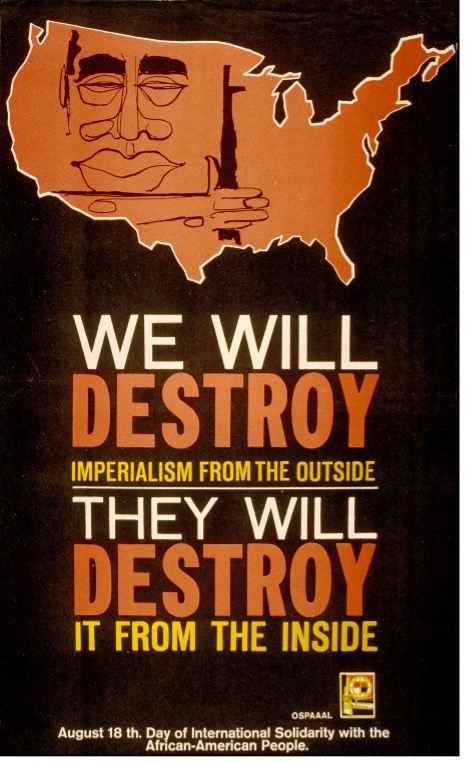

Artists for George [Richard Hart.] Painting of George Floyd. 2020. Museum of the City of New York. Gift of the artist, 2020.
Throughout the Summer of 2020, Black Lives Matter protestors carried paintings of George Floyd through the streets of New York, Washington DC, and Los Angeles. In these memorable paintings, Floyd’s face –– depicted in flat, brilliant colors and a blocky design –– dominates the frame. His gaze, directed slightly away from the viewer, seems to point to a nearby enemy, a subtle reminder of his assassin’s continued impunity. These paintings, created by Brooklyn-based South African artist Richard Hart, share striking design similarities with widely circulated poster images of Trayvon Martin, Michael Brown, Breonna Taylor, and other recent victims of police and white supremacist violence. While these political graphics have become familiar in today’s activism, they have a much longer history, reviving the political artwork of one of the most significant but often forgotten racial justice movements of the twentieth century called the Tricontinental.
The Tricontinental movement formed in 1966 when liberation struggles from eighty-two countries came together at the Tricontinental Conference in Havana, Cuba. At this conference, activists from around the world joined in a movement against global capitalism that focused its critique on racial violence and racial inequality. Through the films, posters, and magazines that the Tricontinental would go on to publish in English, Spanish, French, and sometimes Arabic, and distribute globally, the Tricontinental movement quickly became the driving force of international political radicalism and the primary engine of its cultural production worldwide. Through this cultural production, the Tricontinental played a pivotal role in generating international solidarity with the U.S. Civil Rights Movement as well as with the anti-apartheid struggle, and its vision of global resistance was shaped by the close involvement of African American and Afro-Latinx activists. Although the Tricontinental was most active in the 1960s-70s and is primarily known today for its striking posters, it continued to produce political propaganda until its June 2019 closure.
Recent political artwork draws directly from the history of the Tricontinental movement. For example, Shepard Fairey –– the artist of the Barack Obama “Hope” and iconic Trayvon Martin and Women’s March posters –– has produced several posters that are direct copies of Tricontinental poster images. Similarly, a recent poster of Michael Brown specifically recalls posters created by the Tricontinental after the assassination of African leaders Patrice Lumumba and Amílcar Cabral. The continued relevance of these political graphics speaks to the various ways that contemporary social movements are subconsciously reviving key ideological and aesthetic elements of the Tricontinental.
The Tricontinental: A Brief History
From January 3-5, 1966, five hundred and twelve delegates and two hundred and seventy more observers met at the Tricontinental Conference in the Hotel Habana Libre (previously the Havana Hilton prior to the Cuban Revolution). The conference was historically unprecedentedand drew political leaders like Chile’s Salvador Allende, Uruguay’s Luis Augusto Turcios Lima, and Guinea-Bissau’s Amílcar Cabral, as well as celebrities like performer Josephine Baker and writer Mario Vargas Llosa. The conference would establish the Tricontinental alliance, formally named the Organization of Solidarity with the Peoples of Africa, Asia, and Latin America (OSPAAAL).
The Cuban government spared no expense in the preparations for this event, printing programs in each of the languages represented and planning cultural events, art exhibits, and athletic tournaments to accompany the proceedings. The conference ended with a large assembly for the closing ceremonies in which Fidel Castro gave the final speech in front of towering portraits of revolutionaries of the three continents Ho Chi Minh, Patrice Lumumba, and Augusto César Sandino, and of Cuban leaders José Martí, Antonio Maceo, and Camilo Cienfuegos.

After the Tricontinental Conference, there were smaller meetings of OSPAAAL delegates, but the entire alliance physically met only one time. Instead, its true legacy is its propaganda machine that included Tricontinental Bulletinand Tricontinentalmagazine, published from 1966 to 1990 and then starting again in 1995, as well as posters folded inside the magazine, each devoted to solidarity with a different liberation struggle. It also produced books and pamphlets, radio programs, and newsreels. These materials were published in multiple languages and distributed globally.
The formation of the Tricontinental alliance responded to the 1962 ousting of Cuba from the Organization of American States when Cuba requested to join the Afro-Asian People’s Solidarity Organization. It emerged as part of a growing recognition that Cuba and Vietnam were facing the same enemy and that these struggles should be united. The Tricontinental defined its enemy within the broad framework of economic and military “imperialism,” characterizing it as a global, systemic phenomenon, not tied to any one nation, that could even affect people living inside of the United States. For example, Tricontinental BulletinquotedStokely Carmichael’s view that “imperialism is an exploiting octopus whose tentacles extend from Mississippi and Harlem to Latin America, the Middle East, South Africa and Vietnam.” The Tricontinental reasoned that resistance to this monster must be equally global, a concept articulated by Che Guevara in his 1967 “Message to the Tricontinental” in which he defined the Tricontinental’s revolutionary community as “we, the exploited people of the world.”
From its inception, this movement explicitly stated its inclusion of U.S. African Americans into the alliance, and many Tricontinental materials focused on the U.S. Black freedom struggle. This occurred through official statements, articles, posters that stated the Tricontinental’s solidarity with African Americans, and newsreels, including the six-minute film Now! by Santiago Álvarez, which some have referenced as the first music video and which can now be viewed on YouTube. If imperialism was an octopus covering the earth with its tentacles, then African Americans, the Tricontinental claimed, were fighting “within the guts of the monster itself.” The Tricontinental viewed the Jim Crow South as a microcosm of its global struggle, metaphorically using the Jim Crow categories of “white” and “colored” to signify global imperial oppression versus all radicalized, exploited peoples, regardless of race.
The Tricontinental’s spotlight on the U.S. Black freedom movement was produced through an exchange with African American activists and texts, and Tricontinental publications contained interviews, speeches, letters, and articles by African American activists. In 1968, Black Power leader Stokely Carmichael (a.k.a Kwame Ture) was invited to become a member of the executive secretariat of the Tricontinental, and Robert F. Williams, the North Carolina NAACP activist exiled in Cuba, was present at the first Tricontinental Conference. The ideology and aesthetics of Tricontinentalism also circulated among political radicals outside of Cuba, including among the Black Panthers and the Puerto Rican Young Lords Party in the United States.
Although all Tricontinental materials were produced in post-revolutionary Cuba with the financial backing and bureaucratic support of the Cuban state, much of the content of the articles printed in Tricontinental Bulletin and Tricontinental was provided by members of the particular struggles represented in those materials. For this reason, the views presented in Tricontinental materials did not always align perfectly with the Cuban government’s own positions. This paradox is key for understanding the Castro government’s duplicitous racial politics, in which it used Tricontinental cultural production to critique racial inequality in the United States and South Africa while negating these inequities at home.
In its earliest years, the Castro government made major strides in addressing domestic racial inequalities, especially in the area of desegregation. However, as early as 1962, it proclaimed that racial discrimination had been eliminated by the economic and social reforms in communist Cuba. While the Castro government supported Black liberation abroad through the Tricontinental, it suppressed Black political organizing at home, characterizing it as divisive and counterrevolutionary.
In the 1960s and 1970s, harsh condemnations of Cuba’s racial politics came from U.S. Black militants who spent time in Cuba and wrote about their experiences. For example, Robert F. Williams’ radio show Radio Free Dixie, which he broadcast from Cuba, was criticized by the Cuban government for its promotion of Black militancy. After four years in Cuba, Williams left for China, writing an open letter to Castro criticizing his hypocrisy. Although U.S. Black activists like Angela Davis and William Lee Brent remained supportive, Robert F. Williams, Stokely Carmichael and Eldridge Cleaver all had similar stories of growing distrust of Castro’s government. Despite disillusionment with the Cuban Revolution, Tricontinentalism was forged through an exchange of radical intellectuals across the globe. So even as Black activists like Williams and Carmichael eventually distanced themselves from Cuba, the ideology of Tricontinentalism continued to surface in their writings.
Although the African American struggle continued to feature in Tricontinental materials, as Cuba became involved in the Angolan Civil War, apartheid South Africa replaced the Jim Crow South as the microcosm of the Tricontinental’s global movement. During the late 1970s and 80s, Tricontinental materials employed the same Black/white division to signify a struggle between global empire and all the exploited peoples of the world, drawing comparisons between the U.S. South and South Africa. The Angolan Civil War, in which Cuba provided military backing to the People’s Movement for the Liberation of Angola (MPLA) against militant organizations backed by the United States and South Africa, became a high point of Tricontinentalist solidarity. As a result of the victory of the MPLA, the Castro government negotiated for the independence of Namibia from South Africa in exchange for the removal of Cuban troops from Angola in 1991. This victory is seen as partly responsible for the fall of South Africa’s apartheid regime.
The Returns of Tricontinentalism
Due to the economic crisis of the 1990s in Cuba following the dissolution of the Soviet Union, the production of Tricontinental materials ceased from 1990-1995, beginning again from 1995-2019. Although recent Tricontinental materials have not had the circulation that they once had, this movement’s recent rhetoric has focused on relevant issues like anti-corporatism, anti-neoliberalism, and immigrant rights. Despite its profound historical influence over justice movements around the world, the Tricontinental has been understudied until recently. This oversight is due to a combination of several factors, such as disillusionment with Cuba’s repression of intellectual freedoms, the severe weakening of the Left in the Americas in the 1970s and 1980s, and the regional and linguistic boundaries that have traditionally determined the fields of historic study.
Even so, the history of the Tricontinental is all around us. Contemporary social movements are reviving core aspects of Tricontinentalism in, for example, the aesthetics of its colorful political posters as well as the fast-paced montages of contemporary “political remix videos” that are clearly reminiscent of Tricontinental newsreels. Its influence can also be found in the emphasis of recent social movements on transnational solidarities among oppressed groups, such as the fourteen World Social Forums that have taken place since 2001. Additionally, recent exhibitsof Tricontinental posters and magazines that have taken place in New York, Chicago, London, and Madrid, evince renewed interest in the history of this movement.
These returns in the realms of aesthetics and practice are surface indicators of a deeper ideological revival of Tricontinentalism in the way that contemporary social movements, now more interconnected than ever, are thinking about power and political community on a global scale. But while we are seeing a revival of Tricontinentalism in some ways, its core vision for a global anti-capitalist movement organized around a struggle against anti-Black racism seems to have been left behind. Recent movements directed against global capitalist exploitation such as Occupy Wall Street or the World Social Forum have been criticized for colour-blind discourses of solidarity that overlook racial inequalities. Alternatively, the struggle against violence towards racialized populations –– which has gained significant visibility in the United States and Latin America in recent years –– tends to focus its critique on state government and policing, sidelining a broader consideration of the intersections between racial violence and global capital. For this reason, remembering the history of the Tricontinental is important for what it can teach us today. It provides a model, albeit an imperfect one, for a global justice movement that does not fall into multicultural platitudes and colorblindness but rather that significantly foregrounds the fight against racial inequities and specifically the fight for justice for peoples of African descent.

Anne Garland Mahler (@agmahler) is a scholar of transnational solidarity movements, focused on the Global South. An Associate Professor at the University of Virginia with a PhD in Latin American Cultural Studies (Emory, 2013), Mahler is author of From the Tricontinental to the Global South: Race, Radicalism, and Transnational Solidarity (Duke, 2018), co-editor of The Comintern and the Global South: Global Designs/Local Encounters (Routledge, forthcoming), and the creator and director of the digital publication Global South Studies. Her current project, South-South Solidarities: Racial Capitalism and Political Community from the Americas to the Globe, is supported by a 2020-21 ACLS Fellowship.









